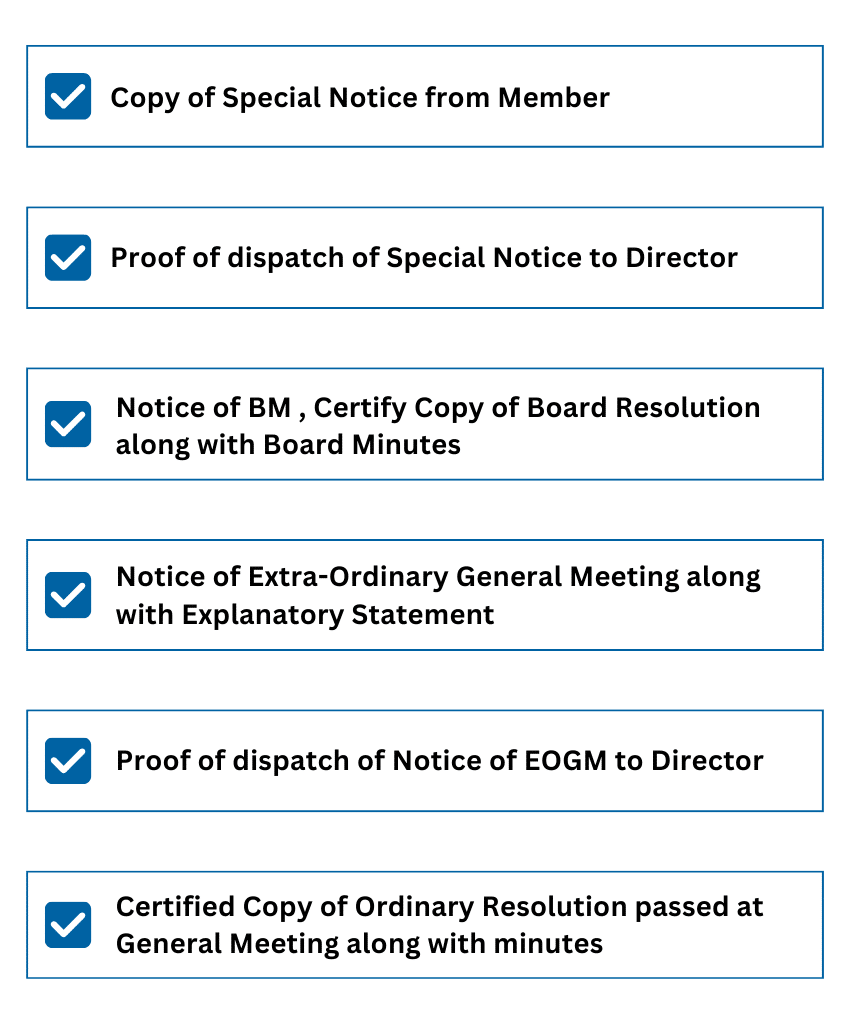Introduction
A company, though an artificial person with a separate legal existence, cannot act on its own and operates through individuals known as Directors. Directors, collectively forming the Board of Directors, are responsible for managing the company’s affairs and acting in the best interest of shareholders. The Companies Act 2013 outlines various provisions such as appointment, resignation, casual vacancy, disqualification, removal of directors, etc.
Section 169 of the Companies Act 2013 grants power to the company to remove a director by passing an ordinary resolution before the expiry of his term. Members intending to propose the removal of a director are required to give special notice to the company at least 14 days before the meeting at which the resolution for removal is to be moved.
The provisions of section 169 shall apply regardless of the way in which the director concerned was appointed and notwithstanding anything contained in the articles of the company or any agreement with the director concerned.
Section 241 of the Companies Act 2013 provides that members can make an application to the National Company Law Tribunal (“Tribunal”) in two circumstances. Firstly, if the company’s affairs are being conducted in a manner detrimental to public interest, oppressive to its members, or prejudicial to the company’s interests.
Secondly, if there is a significant alteration in the management and control of the company, such as changes in the board of directors, membership, or share capital, likely to adversely affect the company or its members. However, changes made in the interest of creditors, debenture-holders, or certain shareholders do not qualify as material changes under this provision.
Section 242(2) outlines a non-exhaustive list of actions the Tribunal can take upon receiving an application and determining that the company’s actions are oppressive. Among these actions is the potential removal of the managing director, manager, or any directors of the company.
For more information on directors, please refer to Directors Vs Shareholders of the Company
We shall discuss in this Article Grounds for removal of director, Compliance Checklist, Procedural aspects. Documents Checklist, Frequently Asked Questions concerning removal of director.
Grounds for Removal of Director
Following are some of the grounds upon which a director can be removed from their position varying from company to company:
Negligent of Duties

Directors owe fiduciary duties to the company and its shareholders, including duties of care, loyalty, and good faith. If a director is found to be negligent of his/her duties, the company may take action for his removal.
Misconduct or Mismanagement

Directors can be removed for engaging in misconduct or mismanagement that harms the company. This may include fraudulent activities, embezzlement, or gross negligence in carrying out their duties.
Loss of Confidence

Directors can be removed on the grounds of losing the confidence of shareholders or other directors due to their inability to perform their duties effectively. This loss of confidence could result from poor performance, ethical lapses, or other factors that undermine the director’s credibility and effectiveness.
Conflict of Interest

Directors must act in the best interests of the company and its shareholders, avoiding personal conflicts of interest. If a director’s personal interests conflict with those of the company, they may be removed.
Violation of Laws or Regulations

If a director is found to be non-compliant with the laws or regulations necessary for the company’s operations, they may be subject to removal. This could include violations of various laws such as company law, environmental regulations, labor laws, and commercial laws.
Compliance Checklist for Removal of Director

a. Governing Laws
Section 169 of the Companies Act 2013, Section 114 of the Companies Act 2013, and Secretarial Standards 2 govern the provisions for Removal of Director.
b. Special Notice
Section 169 of the Companies Act 2013 specifies that a special notice is required for resolution to remove a director. As per Section 115 of the Companies Act 2013, special notice is required to be given to the Company by such number of members
- Holding not less than 1% of the total voting power, or
- Holding shares of aggregate paid-up value not less than Rs 5,00,000 as of the date of Notice.
c. Requisites for Special Notice
Special Notice to be given by the members to the Company shall be signed either individually or collectively by the specified number of members mentioned above as on the date of Notice.
d. Period for Special Notice
Special Notice shall be sent by the members to the company not earlier than 3 months but at least 14 days before the date of the meeting to be convened excluding the day on which the notice is given and the day of the meeting.
e. Sending of Special Notice to Director
Upon the receipt of the special notice of resolution to remove a director, the company shall forthwith forward the copy of the notice to the director concerned.
f. Right to be heard at the meeting
The director whether he is a member of the company or not shall be entitled to be heard on the resolution at the meeting.
g. Publication of Notice
As per Rule 23 of the Companies (Management and Administration) Rules, 2014, and as per Secretarial Standards 2, if it is not feasible to send the notice to all the members of the Company, the notice shall be published in English language in English newspaper and vernacular language in a vernacular newspaper, both having wide circulation in the State where the registered office of the Company is situated and such notice shall also be posted on the website, if any, of the Company.
h. Time period of Publication
The notice is required to be published at least 7 days before the meeting excluding the day of publication of the notice and the day of the meeting.
Procedure for Removal of Director
a. Receipt of Special Notice
Members shall send a special Notice to the Company proposing to pass an ordinary resolution for the removal of the director or to appoint another director in place of a director so removed at the meeting to be convened at least 14 days before the meeting at which the resolution is to be moved.
b. Sending of Special Notice
A copy of the special notice received from the member shall be sent by the company forthwith to the Director. The director in question must also be provided with an opportunity to represent himself/herself at the meeting.
c. Notice of Board Meeting
Prepare and issue notice calling Board Meeting in such manner as prescribed in Sec173(3) of the Companies Act 2013 and Secretarial Standard 1 on Board meetings.
d. Convening a Board Meeting
Conduct a Board Meeting for the following:
- To consider notice received from the member for the removal of the director and pass a resolution for the removal of the director subject to the approval of members in the general meeting.
- To fix the day, date, and time for convening an Extraordinary General Meeting to consider the removal of director
e. Minutes of Board Meeting
In accordance with Section 118 of the Companies Act 2013 and Secretarial Standard 1, the draft minutes should be prepared and circulated to all directors for their review and comments within 15 days from the conclusion of a board meeting.
Directors are required to provide their comments, if any, within 7 days from the date of circulation of the draft minutes. The finalized minutes must be entered into the board meeting’s minute book within 30 days from the date of the meeting’s conclusion. The chairman of the meeting or the chairman of the next meeting should initial, sign, and date the minutes.
The signed minutes, certified by the company secretary or any director (in cases where there is no company secretary), should be circulated to all directors within 15 days of signing, except those directors who have waived their right to receive the signed minutes.
As per Secretarial Standard 1, a director who has ceased to serve on the board, irrespective of their attendance at the meeting, has the right to receive the draft minutes of that particular meeting and is entitled to provide his/her comments.
f. Notice of Extraordinary General Meeting
Prepare and issue a notice calling an Extraordinary General Meeting in such manner as prescribed in Section 101 of the Companies Act 2013 and Secretarial Standard 2 informing about the special notice and proposing the ordinary resolution for removal.
The place, date, day, and time of the meeting and the business to be transacted at the meeting should be mentioned in the Notice of the Meeting.
The mode of sending the Notice of the meeting shall be by Hand/Ordinary post/Speed post/Registered post/Courier/Facsimile/E-mail or any other electronic means.
g. Facts of Representation and Copy of Notice
If the director concerned has made a written representation to the Company and has requested notification to the members then the company is required to state the facts of the representation made by the director concerned in the Notice of General meeting and also send a copy of the representation to every member of the company to whom notice of the meeting is sent (whether before or after the receipt of the representations by the company).
h. Right of Representation at the Meeting
If a copy of the written representation of the director could not be sent to the members due to insufficient time or the company’s default, the director’s right to present their case orally at the meeting remains unaffected, and their representation will be read out during the meeting.
i. Convening of General Meeting
Convene an Extraordinary General meeting of the Company for transacting the matter for the removal of director.
j. Presence of Quorum
Requisite Quorum as per Section 103 of the Companies Act 2013 and Secretarial Standards 2 is required to be present not only at the commencement but throughout the meeting unless the Articles prescribe for a higher number, the Quorum for general meetings shall be as follows:
For public companies:
| Number of Members as of the date of the meeting | Quorum |
| Not more than 1000 | 5 members personally present |
| More than 1000 but upto 5000 | 15 members personally present |
| More than 5000 | 30 members personally present |
For private companies:
| Number of Members as of the date of the meeting | Quorum |
| In case of a private company | 2 members personally present |
k. Chairman to preside over the meeting
As per the Secretarial Standards 2, The Chairman of the Board shall take the Chair and conduct the meeting. In case the Chairman is not available within 15 minutes from the time decided for holding the meeting, or if he is not willing to take the Chair and the meeting, or if no director has been designated, the Directors attending the meeting shall choose one of the Directors among themselves as the Chairman of the meeting.
If the Director is not present within 15 minutes from the time decided for the meeting, or if he is not willing to take the Chair, or if no director has been designated, the Members present shall choose by conducting voting by show of hands to one of the members among themselves take the Chair and preside over the meeting.
l. Appointment of Proxies
Section 105 of the Companies Act 2013 and Secretarial Standards 2 governs the provisions relating to the proxies. The proxy can be appointed by members who are eligible to attend the meeting and carry voting rights. Also, a Proxy is not required to be a member of the Company. Proxies are not considered for considering the quorum for the meeting.
m. Voting at the meeting
Every resolution placed at the meeting shall be firstly put to vote on a show of hands, except a poll has been demanded or the resolution is put to vote by remote e-voting.
n. Passing of Ordinary Resolution
The shareholders must pass an ordinary resolution to remove a director.
o. Filings with MCA
Once the resolution is passed, the company must file E-Forms MGT 14 (wherever applicable) and DIR-12 with the Registrar of Companies (RoC) within 30 days of passing the resolution for removal of the director, along with the necessary fees and supporting documents.
Digital signature is to be affixed by the Director / Manager / CEO or CFO / Secretary of the company and the Practicing Professional. E-Form DIR 12 is an approval-based form (Non-STP Form). E-Form DIR-12 is a web-based form on V3 Portal.
p. Preparation of General Meeting Minutes
Minutes shall be prepared, entered, and signed in the Minutes Book within thirty days from the date of conclusion of the Meeting as per Section 118 of the Companies Act 2013 and Secretarial Standards 2.
q. Entry in the Statutory Register
Necessary entries are required to be made in the register of directors, key managerial personnel, and their shareholding under Section 170 of the Companies Act 2013.
Documents Checklist for Removal of Director
The list of documents required for the removal of director is as follows:

Conclusion
Section 169 of the Companies Act 2013 grants companies the authority to remove a director for reasons such as negligence of duties, fraud, breach of trust, etc., although the specific grounds may vary from company to company.
It’s important to note that the director who is being removed has the right to receive a notice of the general meeting where their removal will be considered and to be heard at the meeting. The process of director removal necessitates thorough legal and secretarial advice and documentation in accordance with the Companies Act, 2013.
At Registration Arena, our team of experienced professionals is dedicated to offering comprehensive guidance for completing the director removal procedure efficiently and promptly.
To get in touch with us, Please contact us
FAQs (Frequently Asked Questions)
i. Are there any exceptions specified in Section 169 of the Companies Act 2013?
Yes, Section 169 of the Companies Act 2013 has 2 exceptions which are as follows:
- Director appointed by the NCLT under Section 242 of the Companies Act,2013 (Powers of Tribunal)
- In such cases where the company has availed the option to adopt the Principle of Proportional Representation for the Appointment of not less than two-thirds of the total number of Directors.As per Section 163 of the Companies Act,2013 the articles of the Company may provide for the appointment of not less than two-thirds of the total number of the Directors of a company in accordance with the principle of proportional representation, whether by the single transferable vote or by a system of cumulative voting or otherwise and such appointments may be made once every three years.
ii. How can a vacancy resulting from the removal of a director be filled under Section 169 of the Companies Act 2013?
As per Section 169 (5) of the Companies Act 2013, A vacancy resulting from the removal of a director, whether appointed by the company in a general meeting or by the Board, can be filled by appointing a new director at the same meeting where the removal occurs.
This requires providing special notice of the intended appointment, as per Section 169(2) of the Companies Act, 2013. The tenure of a newly appointed director extends until the same date that their predecessor would have held office if not removed.
iii. Who is an independent director and Can an independent director be removed?
An independent director means a director who is not a managing director or a whole-time director or a nominee director not having any other relationship or transaction with the company. An independent director’s tenure on a company’s board can extend up to 5 consecutive years, with the possibility of reappointment upon the passing of a special resolution.
However, they are limited to serving a maximum of 2 consecutive terms. After the completion of these terms, they may be considered for reappointment following a 3-year gap, subject to certain conditions.
If reappointed for a second term, the removal of an independent director can only occur via a special resolution by the company, ensuring they are given a fair opportunity to be heard.
iv. What are the implications if a vacancy is not filled under Section 169 of the Companies Act, 2013?
If a vacancy cannot be filled under Section 169 of the Companies Act, 2013, the Board has the authority to fill it as a casual vacancy at a Board meeting which shall be subsequently approved by members in the immediate next general meeting] in accordance with Section 161 (4) of the Companies Act. 2013 However, the director who was removed from office is ineligible for re-appointment by the Board of Directors.
v. Does the removal of a director under Section 169 of the Companies Act 2013 affect the compensation or damages payable to the person removed, or take away the authority to remove a director under other provisions of the Act?
Section 169(8) of the Companies Act 2013 states that the removal of a director under this provision does not affect his entitlement to compensation or damages according to their contract or terms of appointment. Additionally, it clarifies that the section does not take away any authority to remove a director under other provisions of this Act.
vi. Under what circumstances can the National Company Law Tribunal waive the requirement of sending a copy of a representation and reading it out at the meeting?
The National Company Law Tribunal, upon being satisfied by an application from the company or any aggrieved party, has the authority to waive the requirement of sending a copy of the representation and reading it out during the meeting if such action is deemed to be seeking unnecessary publicity for defamatory content.









